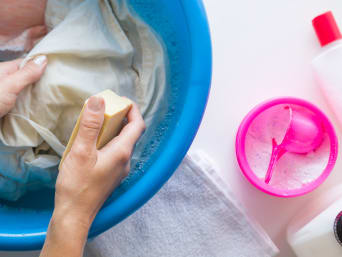Removing stains and bad odours from clothes
If you want to remove stubborn stains and dirt from clothes, you may need to pre-treat your clothes before putting them in the wash. Unfortunately, some stains can be quite stubborn and they don’t wash out just after one wash. It is recommended to do a thorough pre-treatment for all kinds of stains. You don’t always have to use an expensive stain and odour remover. Most of the time simple home remedies and a few tips are enough to get your clothes looking and smelling great again.
In this article you can find out more about what home remedies you can use to remove various stains and also what you should keep in mind when pre-treating them. We will also show you how to get rid of unpleasant odours from clothes.
Removing stubborn stains: how to get your clothes clean again
There are a few basic rules you should follow when trying to remove any type of stain from your clothes. Removing stains from your clothes always requires the utmost care. If stains are not treated properly then they may become permanent and you may not be able to remove them from your clothes. Stains should also be immediately treated as fresh stains are easier to remove than older ones.
Tip: If you are treating a stain, make sure the work surface is clean. Ideally, you should also protect the work surface from discolouration.
Tips on using home remedies to remove stains
There are so many different types of stains and a lot of different ways you can remove them. Trying to remove stains with home remedies on durable materials like cotton have been tried and tested. Some of the following products have been used as home remedies to remove stains: dry shampoo, baby powder, white vinegar, gall soap and toothpaste. However, which remedy should be used for which stain?
Below we will show you how to remove the most common types of stains with home remedies.

Before using home remedies or stain removers make sure to check the item of clothing for colour fastness and any delicate materials. This applies especially to acidic products in combination with coloured clothing and delicate materials. Therefore, always test the stain remover on a small part of the clothing that is not easily noticeable. If you notice a loss of colour or if the properties of the fabric have changed then it is recommended to take the item of clothing to a dry cleaner to be cleaned.
How to remove blood stains
One of the most common types of stains are blood stains. Before trying to remove a fresh blood stain, it is important to pre-treat it. Firstly, soak the item of clothing in some cold water for half an hour. Then squeeze it gently and most of the stain should now have been removed. Then pop the item of clothing into the washing machine and wash as usual.
Older blood stains are not as easy to remove, but they can be removed just as effectively. As described above you should soak the blood stain in some cold water beforehand and then gently squeeze the water out of it. Rub a bar of gall soap gently over the stain so that it can soak into the fibres. Leave the soap to soak in and then rinse with some cold water and pop the item of clothing into the washing machine and wash as usual. You can use various home remedies to remove a dried blood stain:
Gall soap: rub a bar of gall soap gently over the stain so that it can soak into the fibres. Leave the soap to soak in for a while and then rinse with some cold water and pop the item of clothing into the washing machine and wash as usual.
Baking soda and baking powder: these two home remedies are suitable for removing blood stains from light coloured textiles. Moisten the stain and then sprinkle some baking soda or baking powder over it. After about 2 to 3 hours, you can rinse your item of clothing and wash it as usual.
Lemon juice: you can also remove stubborn blood stains on light coloured clothes by drizzling a little lemon juice over the stain and leaving it to soak for about an hour. However, be mindful when using lemon juice as it can have a bleaching effect.
How to remove red wine stains
Cold water is a proven quick remedy to remove fresh red wine stains. The first step is to dab the stain dry and immediately rinse the area thoroughly with some cold water. Alternatively, you can also use some sparkling water. Gently rubbing the stain will also help to prevent the red wine's colourants from sticking to the fibres. Then pop the item of clothing into the washing machine and wash as usual.
Salt is also a proven way to remove a fresh red wine stain. Simply apply enough salt to the stain so that it is completely covered. This way the stain will be absorbed. You can then wash the item of clothing in the washing machine as usual. You can use dry shampooin case the stain is on a delicate material such as cashmere or silk. Spray the stain and as soon as it has been absorbed carefully dab it to remove any remaining dry shampoo.
Removing an older red wine stain is trickier and time consuming. Firstly, put a tablespoon of washing powder or washing-up liquid in a bowl of cold water and soak the stain in it for an hour. Gently rub over the stain with a small brush to help the mixture soak into the material. Finally, rinse the stain with some cold water and then pop it into the washing machine and wash as usual.
Tip: You can also use this suggested method to remove carrot, tomato and ketchup stains.
How to remove grass stains
In order to remove grass stains from your clothes, you will need a whitening toothpaste which contains menthol. This home remedy is suitable for all light coloured fabrics, such as white T-shirts or light coloured jeans. Simply spread the toothpaste over the stain, then leave it on for an hour and rinse thoroughly with some warm water. Gall soap is a great alternative for older stains or if the material is darker. To remove grass stains on dark coloured clothes such as jeans, you can use gall soap on the dampened material and leave it for about an hour.
How to remove grease and oil stains
Grease and oil can quickly soak into the fibres on the material, therefore, it is important to try to remove the stain as quickly as possible. Old grease and oil stains unfortunately cannot be removed very easily with home remedies, therefore, they will need to bedry cleaned. However, if you treat the stain before it dries in, then the grease or the oil can be quickly removed.
To do this, try and soak up as much of the grease or oil as possible from the fabric
using a piece of kitchen towel.
Next dissolve a tablespoon of laundry detergent in a bowl of hot water
and wash the grease or oil stain in it. You can also use a washing-up liquid as an alternative.
Finally, wash the item of clothing at the highest possible temperature shown on the
You can use baby powder, cornflour or dry shampoo to soak up the grease on delicate materials. Alternatively, on delicate materials such as silk you can also use a little bit of white spirit. However, always make sure to check whether you can use such products on delicate materials. This can be done by putting a small dab onto a part of the material which is not very visible.
Getting chewing gum off clothes
Removing chewing gum from clothing is quite easy. You will just need a freezer bag and a freezer. Put the item of clothing into the freezer bag and then pop it into the freezer and leave it overnight. The next day you can easily just scrape off the chewing gum. Small chewing gum residues can then be removed by using a little bit of white spirit. To do so, simply put a small amount onto a cloth and then rub it over the remains of the chewing gum.
Getting rid of bad odours from your clothes
It is not uncommon for even freshly washed clothes to smell a little bit unpleasant. Unfortunately, depending on the odour one wash sometimes isn’t enough to remove all the bad odours. Even stains can leave an unpleasant smell even after they have been removed. Whether it's the smell of sweat, damp washing or smoke try some of the methods below to get your clothes smelling fresh again.
How to remove the smell of sweat from clothes
Sweat smells are a common bad odour that can be quite stubborn to get rid of. Even wearing deodorant won’t make much of a difference due to the bacteria in the material’s fibres. If you do apply deodorant this can make the bad odour even stronger.
To remove the smell of sweat from your clothes, you have different options that you can use on light or dark fabrics:
For dark coloured clothes you can use vinegar to get rid of the smell and odour causing bacteria. Simply fill a large bowl with some warm water, add a large bottle of vinegar and put the clothes into the mixture. Leave it to soak for about an hour to kill the bacteria. After the pretreatment, you can wash the item of clothing as usual.
In case the odour has soaked into lighter coloured clothing then it is recommended to use some citric acid, which also has an antibacterial effect. Firstly, simply mix a litre of warm water with a little bit of citric acid in a bowl and soak the item of clothing in it and then afterwards machine wash as usual. The citric acid also ensures that any deodorant marks will be lightened.
How to remove the smell of smoke from clothes
In addition to sweat, the smell of smoke is one of the most common causes of bad smelling washing. To remove the smell of smoke from your clothes the item of clothing should be hung up outside and left to air out in the fresh air preferably overnight. An alternative option would be placing the item of clothing in the freezer, which helps to break down any bacteria. If you don’t have a lot of time, you can achieve a similar effect with heat. The warm air from a hairdryer ensures that unpleasant odours quickly dissipate.
How to freshen up damp smelling clothes
Even washing which has been washed can sometimes give your wardrobe a damp smell. There are a couple of reasons why this happens: either the washing was not completely dry or the damp smell is coming from the washing machine itself.
To prevent your washing from smelling damp you should always make sure that the washing is fully dry before putting it away. You should also clean your washing machine regularly. This includes wiping the rubber rims on the washing drum to remove any residual dirt. If your clothes continue to smell damp after cleaning the washing machine, then it can be down to the bacteria in the fibres. Depending on the material you could wash your clothes at a higher temperature, use a laundry detergent containing bleach or you could try a pre-treatment with a home remedy such as bicarbonate of soda, vinegar or citric acid to help disinfect and kill the odour causing bacteria.
Conclusion: removing stains with home remedies
Following our stain removal guide will help you to remove some stubborn stains and bad odours. You don’t necessarily need to get rid of an item of clothing due to a stain. In addition to dry cleaning, there are a number of home remedies that can quickly remove the most common types of stains such as blood, chewing gum, red wine, etc. If you want to remove stubborn stains from your clothes, you should always do so carefully and with care. Not all stains and fibres can be treated with home remedies. If the material is too delicate or you are unsure, it is best to get your clothes dry cleaned.
______________________________________________
The image sources in this text are in chronological order
Cover photo: iStock.com/FotoDuets
1. Image in text: iStock.com/svehlik
2. Image in text: iStock.com/ArtisticCaptures
3. Image in text: iStock.com/PeopleImages














